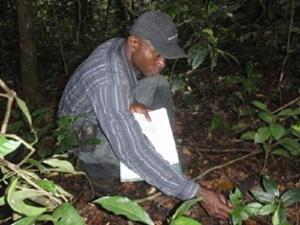Inaoyom Imong
The projects aims is to determine the ecological and anthropogenic causes of the current patchy
distribution of Cross River gorillas, and determine the quantity and location of suitable habitat where conservation action can be focused.

Inaoyom Imong collecting data.
Cross River gorillas, the rarest and most endangered subspecies of African ape, number fewer than 300 individuals in 11 discrete localities in the mountainous Cross River region on the border between Nigeria and Cameroon. In many cases these localities are connected by large areas of forest which are not used by the gorillas. This project investigates the causes of the current patchy distribution of these gorillas. By identifying ecological and anthropogenic reasons for the current pattern of the gorillas? distribution, the study will provide data essential for planning future conservation actions.

Inaoyom Imong counting herbs in a plot.
This research will allow an assessment of whether forest currently unoccupied by gorillas represents suitable gorilla habitat and assess the long-term conservation prospects of Cross River gorillas in Nigeria. Field data and satellite imagery will be used to model the distribution of suitable gorilla habitat and potential future distribution of Cross River gorillas in Nigeria. By identifying where suitable gorilla habitat occurs it will be possible to focus conservation actions on areas that will allow the current population to expand both its size and range, and allow essential connectivity between groups to maintain genetic viability of population. The project also investigates how local culture and economics impact the distribution of the gorillas. This will provide information to guide management strategies to reduce human impact on gorilla habitat.
The study is being conducted at three sites in south-eastern Nigeria ? the Okwangwo Division of Cross River National Park, the Afi Mountain Wildlife Sanctuary and the Mbe Mountains Community Wildlife Sanctuary. The forests of these sites form part of the Cross-Sanaga-Bioko coastal forest eco-region. Vegetation sampling over the study area (c. 1000km2) including areas occupied by gorillas and unoccupied areas will allow an assessment of the availability of gorilla food plants in areas used habitually by gorillas and areas not used. In addition, other habitat characteristics such as altitude and slope will be assessed. Anthropogenic disturbance will be assessed in areas habitually used by gorillas and areas not used by gorillas to determine how human activity influences Cross River gorilla distribution.
A socioeconomic survey conducted in twelve communities living next to the gorillas across their range in Nigeria will provide information regarding how local culture and socioeconomic factors influence the occurrence of illegal activities in gorilla habitat, and how local culture could be harmonised with conservation programmes to improve Cross River gorilla conservation.